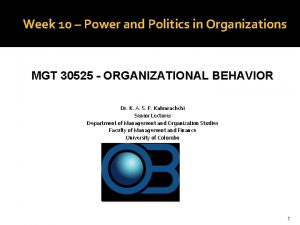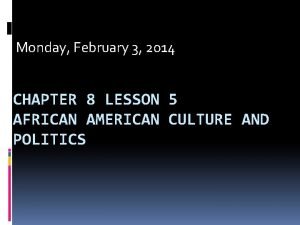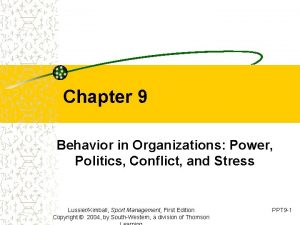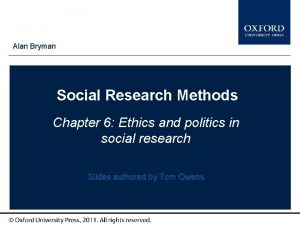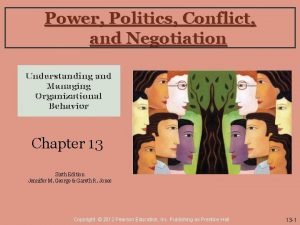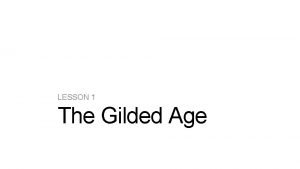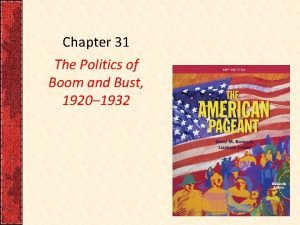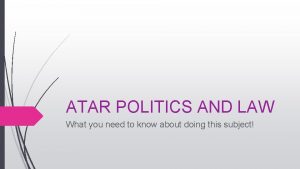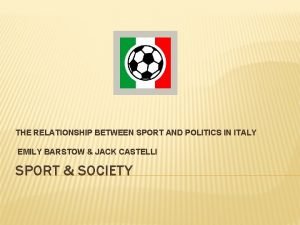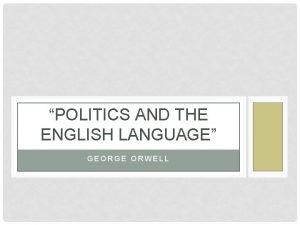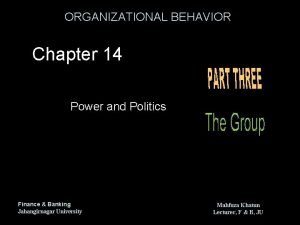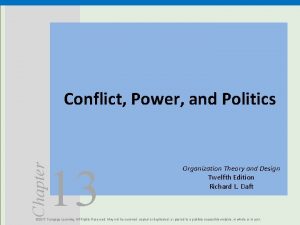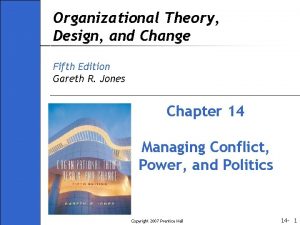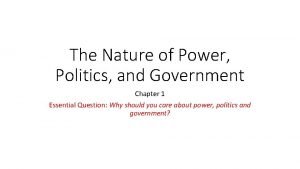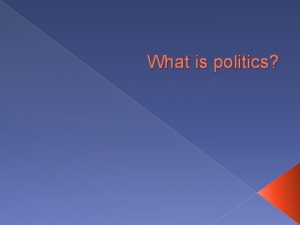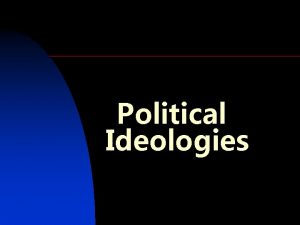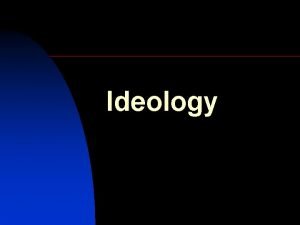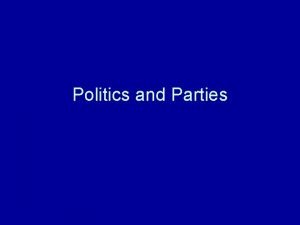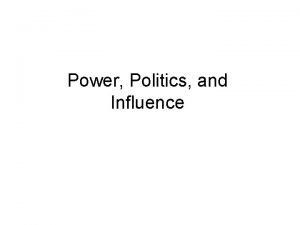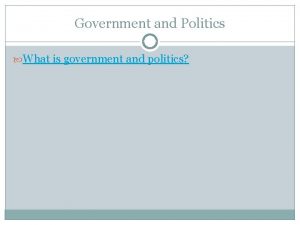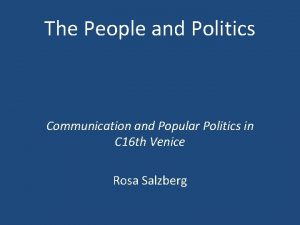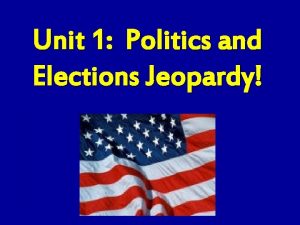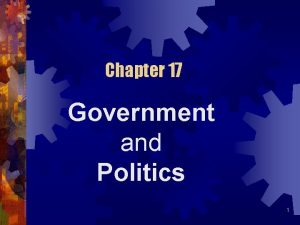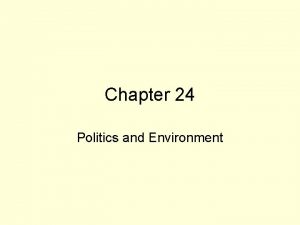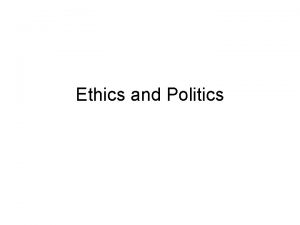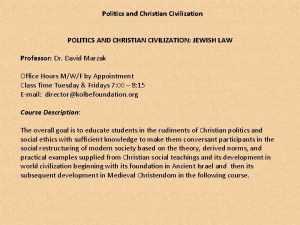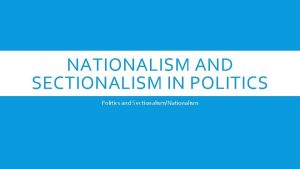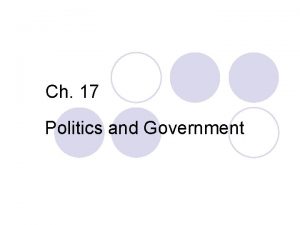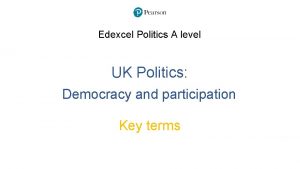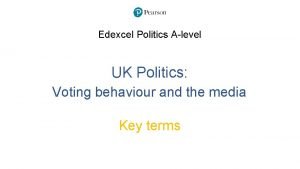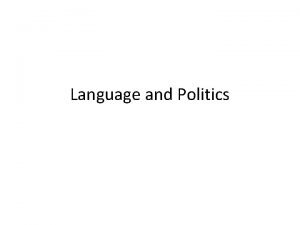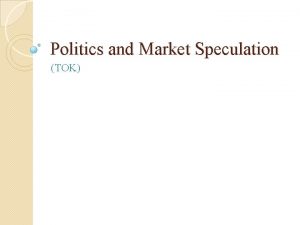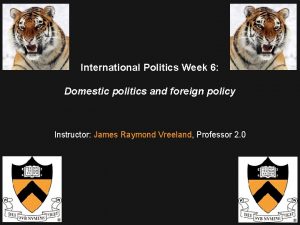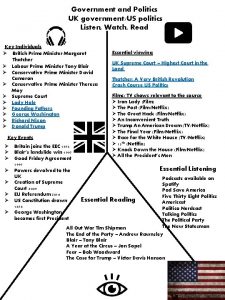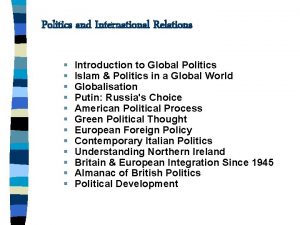Ideas and Politics The role of ideas in







































- Slides: 39

Ideas and Politics

The role of ideas in politics What people think and believe about society, power, rights, etc. , determines their actions How do the ideas and beliefs appear in our minds? Critical examination of reality – thinking for oneself Influence of others’ opinions – family, education, culture, mass media, etc.

Some ideas serve the function of social control, reconciling people with the existing social order Subjugation by force is the crudest form of social control Controlling people through persuasion is a much more effective method But mind control is never absolute The mind has a natural urge to know the truth and be free to seek it https: //www. youtube. com/watch? v=dbw. QXVcbk. U 0


The forbidden fruit of knowledge

Enlil and Enki, two of the Sumerian gods, 28 th century BCE Enlil is the top ruler who orders the creation of mankind which would be slaves of the gods; demands strict obedience Enki is the god of water, knowledge, mischief, crafts and creation Enki is sympathetic to humans and gives them knowledge

2 main concepts concerning the role of ideas in politics Political culture – the broad pattern of political orientations shared by a large group of people (a nation, a region, a class, an ethnic group) Political ideology – a system of political ideas, developed for the purposes of political action (governing a country, launching a social movement or a political party, organizing a revolution – or a counterrevolution, etc. )

What are political ideologies for? To provide people with programs of political action: to govern societies, or to struggle for change Both for integration and for conflict, you need an ideology – a coherent set of ideas for purposeful action

The earliest ideologies were religions. Many of the earliest rulers in history were priests. In the Modern Age, political ideologies become increasingly secular (non-religious, some antireligious), but religions continue to serve as important sources for ideologies to this day Examples: Christian democracy, Christian socialism, Protestant fundamentalism, varieties of political Islam

It is the very essence of political ideology to differ from another ideology on what to do with the status quo (the existing order of things): To keep it – or to change it. At the core of every political idea, every political action is a choice between YES and NO. Look at the work of the parliament… Or the UN… Or an election… The differences between ideologies are rooted in basic assumptions about: human nature – are humans naturally peaceful, cooperative, rational? individual and society: which interests come first? equality: how much social inequality is acceptable?

Ideology vs. pragmatism Should one’s political beliefs be based on one ideology? Shouldn’t politicians be free to borrow ideas from different ideologies if they work better in a particular situation? At issue: orthodoxy vs. pluralism Orthodoxy (traditionalist, pre-modern view): the rulers should maintain one ideology as dominant – to foster unity and harmony in society. UNITY THROUGH UNIFORMITY Can work only: in traditional, pre-modern societies – or, in societies in transition to modernity, in periods of extreme crisis.

Pluralism (the modern view associated with liberalism): the rulers allow different ideologies in society to compete. UNITY THROUGH TOLERATION OF DIFFERENCES “E pluribus unum” Works better in developed, modern and postmodern, complex societies with high educational levels Are there limits to toleration? Do the rulers privilege some ideologies over the others? Should some ideologies be banned? Is there such a thing as liberal orthodoxy?

The challenge of the liberal-democratic type of politics To accept ideological pluralism as a normal condition of society And try to maintain social unity through toleration of differences and management of conflict It is not always possible Some ideologies can coexist with each other Others are so strongly opposed to each other that they cannot be reconciled by means of compromise Ideological polarization of America: http: //www. pewresearch. org/fact-tank/2017/10/23/inpolarized-era-fewer-americans-hold-a-mix-of-conservative -and-liberal-views/

“The smart way to keep people passive and obedient is to strictly limit the spectrum of acceptable opinion, but allow very lively debate within that spectrum—even encourage the more critical and dissident views. That gives people the sense that there's free thinking going on, while all the time the presuppositions of the system are being reinforced by the limits put on the range of the debate. ” Noam Chomsky, The Common Good, 1998

Political Spectrum: From Left to Right Political ideologies, through opposition, competition, fusion, mixing, etc. – exist in constant interaction with each other Together, they form a political spectrum It is a useful tool of political analysis

The terms “Left” and “Right” originate from the seating of the members of the newly elected French Legislative Assembly in 1791 – during the French Revolution The Left: The Right: Advocates of radical change, republicans Supporters of the existing order, monarchists King Louis XVI Legislative Assembly


It was in the interests of the King to be able to manage the conflict between Left and Right – through centrist, pragmatic policies, borrowing ideas for state policy from both sides and trying to build a consensus It proved impossible. France experienced a revolution – a radical change of the political and social order But even then, there were people in the middle between the extremes Extremists vs. moderates In normal conditions, the political spectrum includes a range of ideological “colours” between the extremes

At least three… Far Left Centre-Right Far Right

Political spectrum: the standard linear model Far Left Centre- Left Socialists Communists Centre- Right Liberal Conservatives Liberals Radicals Far Right Ultraconservatives Conservatives Fascists Reactionaries

Ideologies associated with different fields of political spectrum

The Right: Conservatism – preserve the status quo, oppose change Reaction – throw back the forces of change, restore the old order Fascism – destroy democracy, repress all opposition and dissent, concentrate power in the hands of the top leader, mobilize the nation for war

The Left: Radicalism – go to the roots of problems, change the foundations of society Socialism – more democracy, defend advance the interests of workers through social reforms and redistribution of income Communism – mobilize workers to overthrow the capitalist class, abolish private property, build a one-party state with a planned state-owned economy

The Centre: Liberalism – expand the scope of freedom, accept change, assert the primacy of individual rights, develop market economy and political pluralism Borrow ideas from Left and Right

There are several dimensions here: Change or preservation of status quo Freedom or order Pluralism or orthodoxy Equality or inequality Market or state Ideas interact, travel across the spectrum… Too many possible combinations… How can all these complexities be taken into account?

Political spectrum: a 2 -dimensional model Market Welfare state liberalism Neoliberalism Market authoritarianism Social democracy Market socialism Right Left Traditional conservatism State socialism Fasci sm (Communism) State

You may use 3 or more dimensions… Market Inequality Democracy Authoritarianism Equality State

Political spectrum: the circular model, based on Clinton Rossiter the market, trade CONSERVATISM LIBERALISM THE LEFT: THE RIGHT: change, freedom, equality, labour status quo, order, inequality, capital COMMUNISM FASCISM the state, war

Three major factors which produce, shape and reshape ideologies: TIME CLASS CRISIS

TIME The flow of time – and the notion of change The course of history Social evolution and development The centuries of modernization The issue of change social, technological, cultural, economic Also: age (individuals, countries, systems) and readiness to embrace change The influence of liberalism today is partly explained by the fact that liberalism was created as the ideology of change. Conservatism’s main problem: how to keep order in a changing world

CLASS Each major ideology has its main roots in the interests of a certain class, or a section of a class, or several aligned classes For instance, in 19 th century Europe: Conservative ideologies were rooted in the interests of landed aristocracy and clergy – classes losing power as a result of modernization Liberalism was rooted in the interests of the rising bourgeoisie Socialism was rooted in the interests of the working classes The special role of the intellectuals in the production of ideas

CRISIS A catastrophe (major war, economic collapse, ecological disaster, famine) Major deterioration of social conditions Breakdown of a state A revolution or a counterrevolution Crises create powerful demand for new ideas And people commit themselves to ideas much more strongly (become more ideological) than in normal times

Liberalism, conservatism, socialism, and fascism have offered comprehensive political worldviews Other important ideologies which have not developed into comprehensive systems of thought but have had major influence on national and global politics:

Nationalism: creating (or restoring) independent states, fostering national unity Anarchism: rejection of the state as a social mechanism Feminism: struggle for gender equality Environmentalism: saving the planet Religious fundamentalisms: establishing a social order on the basis of religious orthodoxy

Populism nhttps: //www. youtube. com/watch? v=_u. A 1 GBz. Xzr 4

The ideological conflict in the Cold War nhttps: //www. youtube. com/watch? v=co 5 ut 5 cfquk

Political compass: nhttp: //www. politicalcompass. org/

The Democratic Party in the US is moving left. Will America follow? nhttps: //www. washingtonpost. com/magazine/2019/1 1/12/democrats-are-moving-left-will-america-followperspectives-partys-dramatic-turn/? arc 404=true

Explore the Canadian political spectrum Liberals https: //www. liberal. ca/wpcontent/uploads/2012/12/LPCmission. vision. values_web. pdf Conservatives https: //cpcassets. conservative. ca/wpcontent/uploads/2019/04/03155337/KXBCNk. Wf. X 3 IDt. R. pdf NDP https: //xfer. ndp. ca/2017/Documents/2016_POLICYEN. pdf The Green Party https: //www. greenparty. ca/en/platform/introduction Bloc Quebecois https: //www. blocquebecois. org/independance/argumenta ire/
 Azure web role vs worker role
Azure web role vs worker role Krappmann schaubild
Krappmann schaubild Statuses and their related roles determine the structure
Statuses and their related roles determine the structure Power and politics in organizations
Power and politics in organizations Opportunity and challenges of media
Opportunity and challenges of media Chapter 8 lesson 5 african american culture and politics
Chapter 8 lesson 5 african american culture and politics Bureaucracy and politics in india
Bureaucracy and politics in india Power, politics and conflict in organizations
Power, politics and conflict in organizations Ethics and politics in social research bryman
Ethics and politics in social research bryman Power, politics and conflict in organizations
Power, politics and conflict in organizations Philosophy, politics and economics michael munger
Philosophy, politics and economics michael munger The tournament of today
The tournament of today Chapter 31 the politics of boom and bust
Chapter 31 the politics of boom and bust Chapter 20 whose government
Chapter 20 whose government Polis bsc
Polis bsc Unit 1 study guide government
Unit 1 study guide government Politics and law atar
Politics and law atar Relationship between sport and politics
Relationship between sport and politics Politics and the english language
Politics and the english language Illegitimate political behavior
Illegitimate political behavior Power and politics organization theory
Power and politics organization theory Power and politics
Power and politics The nature of power politics and government
The nature of power politics and government Hình ảnh bộ gõ cơ thể búng tay
Hình ảnh bộ gõ cơ thể búng tay Ng-html
Ng-html Bổ thể
Bổ thể Tỉ lệ cơ thể trẻ em
Tỉ lệ cơ thể trẻ em Gấu đi như thế nào
Gấu đi như thế nào Tư thế worm breton là gì
Tư thế worm breton là gì Chúa yêu trần thế
Chúa yêu trần thế Các môn thể thao bắt đầu bằng tiếng đua
Các môn thể thao bắt đầu bằng tiếng đua Thế nào là hệ số cao nhất
Thế nào là hệ số cao nhất Các châu lục và đại dương trên thế giới
Các châu lục và đại dương trên thế giới Công của trọng lực
Công của trọng lực Trời xanh đây là của chúng ta thể thơ
Trời xanh đây là của chúng ta thể thơ Mật thư anh em như thể tay chân
Mật thư anh em như thể tay chân 101012 bằng
101012 bằng độ dài liên kết
độ dài liên kết Các châu lục và đại dương trên thế giới
Các châu lục và đại dương trên thế giới Thể thơ truyền thống
Thể thơ truyền thống



